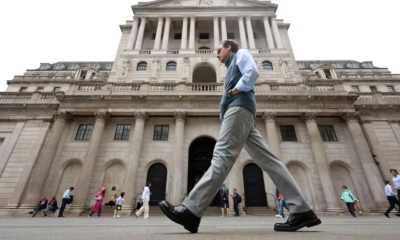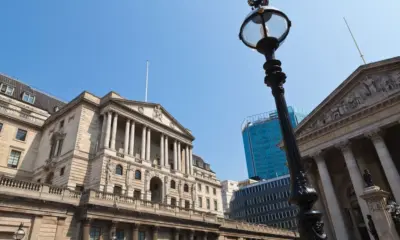Business
BoE Maintains Policy Rate for Sixth Straight Month amid Inflation Uncertainty

Introduction
The Bank of England has opted to maintain its benchmark interest rate for the sixth consecutive month, signaling a cautious stance as it navigates persistent inflation and a fragile economic recovery. The Monetary Policy Committee (MPC) voted to keep the base rate unchanged at 4 percent in its October meeting, reflecting an ongoing balancing act between curbing inflation and avoiding a deeper slowdown. Despite early signs that inflationary pressures are easing, policymakers remain wary of premature policy loosening that could reignite price growth.
The decision marks a continuation of the central bank’s wait-and-see approach after one of the fastest tightening cycles in recent history. Between late 2021 and mid-2024, the Bank raised rates 14 times to counter surging prices. The current hold underscores the view that monetary conditions are now sufficiently restrictive to bring inflation closer to the 2 percent target over time, though risks remain tilted toward persistence in services and wage-driven inflation.
Inflation Trends and Policy Context
Headline consumer price inflation has eased significantly from its peak above 10 percent in 2022 to around 3.8 percent in recent months. However, the underlying picture remains complex. Core inflation, which excludes energy and food, continues to hover near 3.5 percent, suggesting that domestic cost pressures are still embedded in the economy.
Energy price declines and supply chain normalization have provided temporary relief, but services inflation, reflecting labor and housing costs, has proven stubborn. The Bank’s latest forecast anticipates that inflation will remain above target through mid-2026 before gradually converging to 2 percent. This projection aligns with market expectations that interest rates will remain elevated for an extended period to ensure price stability.
Governor Andrew Bailey emphasized the importance of patience and prudence, stating that while progress has been made, the Bank is not yet confident inflation will stay low without continued restraint. Policymakers are watching closely for sustained evidence of moderation in wage growth, which has remained around 5 percent year-on-year, well above levels consistent with the inflation target.
Balancing Inflation Control and Growth Risks
The decision to hold rates comes amid growing concerns about the pace of economic activity. Recent data show that the UK economy expanded by a modest 0.9 percent in the third quarter, up from 0.6 percent in the previous quarter. While growth remains positive, it is fragile and uneven across sectors. Consumer spending continues to be constrained by high borrowing costs and stagnant real wages, while business investment has been held back by uncertainty over future policy and global trade conditions.
Manufacturing output and construction activity have shown mild improvement, supported by easing input costs and stabilization in supply chains. However, the services sector, which represents nearly 80 percent of GDP, has softened as households and businesses trim discretionary spending. The Bank faces a difficult trade-off: lowering rates too soon risks reigniting inflation, while maintaining them too high for too long could choke off what little growth remains.
Markets had speculated that the MPC might signal a pivot toward easing in early 2026, but the tone of the latest statement suggests that such a move is still some way off. The committee reaffirmed that monetary policy will remain restrictive for as long as necessary to bring inflation sustainably to target. This cautious communication aims to anchor inflation expectations and avoid volatility in financial markets.
Labour Market and Wage Pressures
The labor market continues to play a pivotal role in shaping the inflation outlook. Unemployment has inched up to 4.5 percent, reflecting slower hiring and some cooling in demand for workers. However, the market remains tight by historical standards, with vacancies still above pre-pandemic levels. Wage growth remains robust, particularly in services and professional sectors, contributing to inflation persistence.
Policymakers have expressed concern that high wage settlements could feed into future price rises, creating a feedback loop that would make inflation harder to tame. While there are tentative signs of moderation, the Bank is waiting for clearer evidence that pay pressures are easing before considering rate cuts.
At the same time, household finances are under strain. Rising mortgage costs continue to weigh on consumer sentiment, especially among homeowners transitioning from fixed-rate deals to higher variable rates. This has slowed retail spending and increased precautionary savings, dampening short-term economic momentum.
Financial Markets and Investor Reaction
The Bank’s decision to maintain rates was widely anticipated by financial markets, though traders were attentive to the tone of accompanying statements. Government bond yields edged slightly lower following the announcement, reflecting investor confidence that the tightening cycle has peaked. The pound held steady against the dollar and euro, suggesting that the decision was fully priced in.
Equity markets reacted modestly, with banking and real estate stocks showing minor gains on expectations that stable rates could reduce uncertainty in the mortgage and lending sectors. However, the broader investment community remains cautious, noting that the Bank’s commitment to keeping rates elevated could weigh on corporate borrowing and expansion plans.
Analysts expect the first rate cut to come no earlier than the second half of 2026, contingent on a sustained drop in inflation and clearer signs of economic slack. Until then, financial conditions are likely to remain tight, shaping a cautious environment for both households and businesses.
International Comparisons and Global Dynamics
The Bank of England’s decision mirrors similar moves by other major central banks. The European Central Bank and the Federal Reserve have also paused their tightening cycles as inflation cools but remains above target. Globally, central banks are facing the challenge of achieving a soft landing while avoiding renewed inflationary surges.
International factors such as oil price fluctuations, geopolitical risks, and global supply constraints continue to influence the UK’s inflation trajectory. The recent stabilization in energy prices has eased some external pressure, but renewed tensions in global trade could disrupt this progress. The Bank remains alert to these external headwinds and their potential impact on domestic inflation and growth.
Conclusion
The Bank of England’s decision to maintain the base rate for a sixth consecutive month underscores a cautious but deliberate approach to monetary management. While inflation has moderated substantially, it remains well above the 2 percent target, and underlying pressures persist in wages and services. The Bank is signaling that it is not yet time to declare victory over inflation, even as growth slows and financial conditions tighten.
For households, the implications are mixed. Borrowing costs are likely to stay high for the foreseeable future, putting continued pressure on mortgage holders and consumers. Yet the stability of rates may also provide some predictability, allowing markets and businesses to plan with greater confidence.
As the UK economy transitions into a new phase of post-pandemic normalization, the Bank faces an intricate balancing act. Sustained vigilance, data-driven decision-making, and clear communication will be essential to restore price stability without derailing the fragile recovery. The coming months will test the Bank’s resolve as it navigates the fine line between restraint and support in a volatile global environment.




















